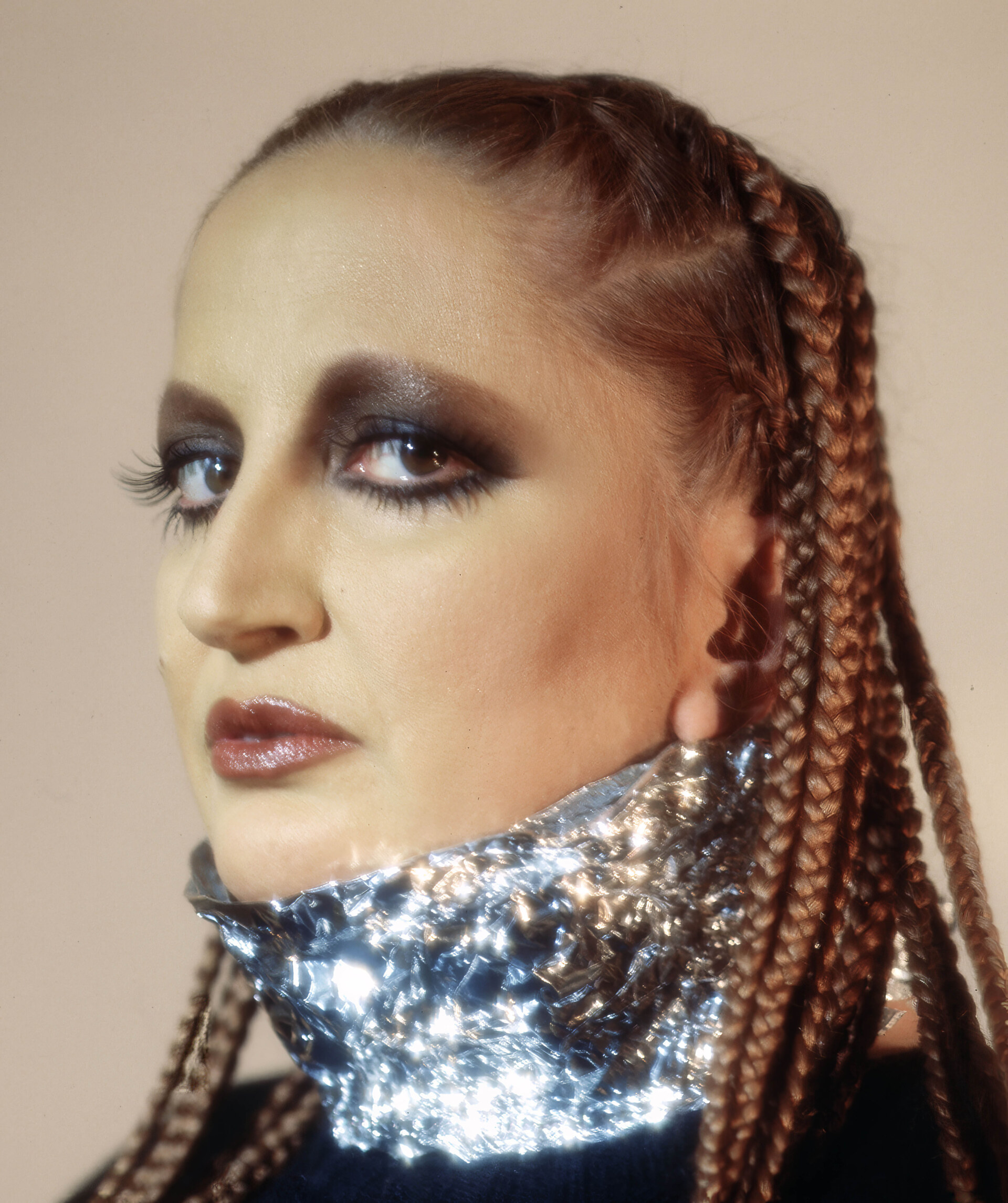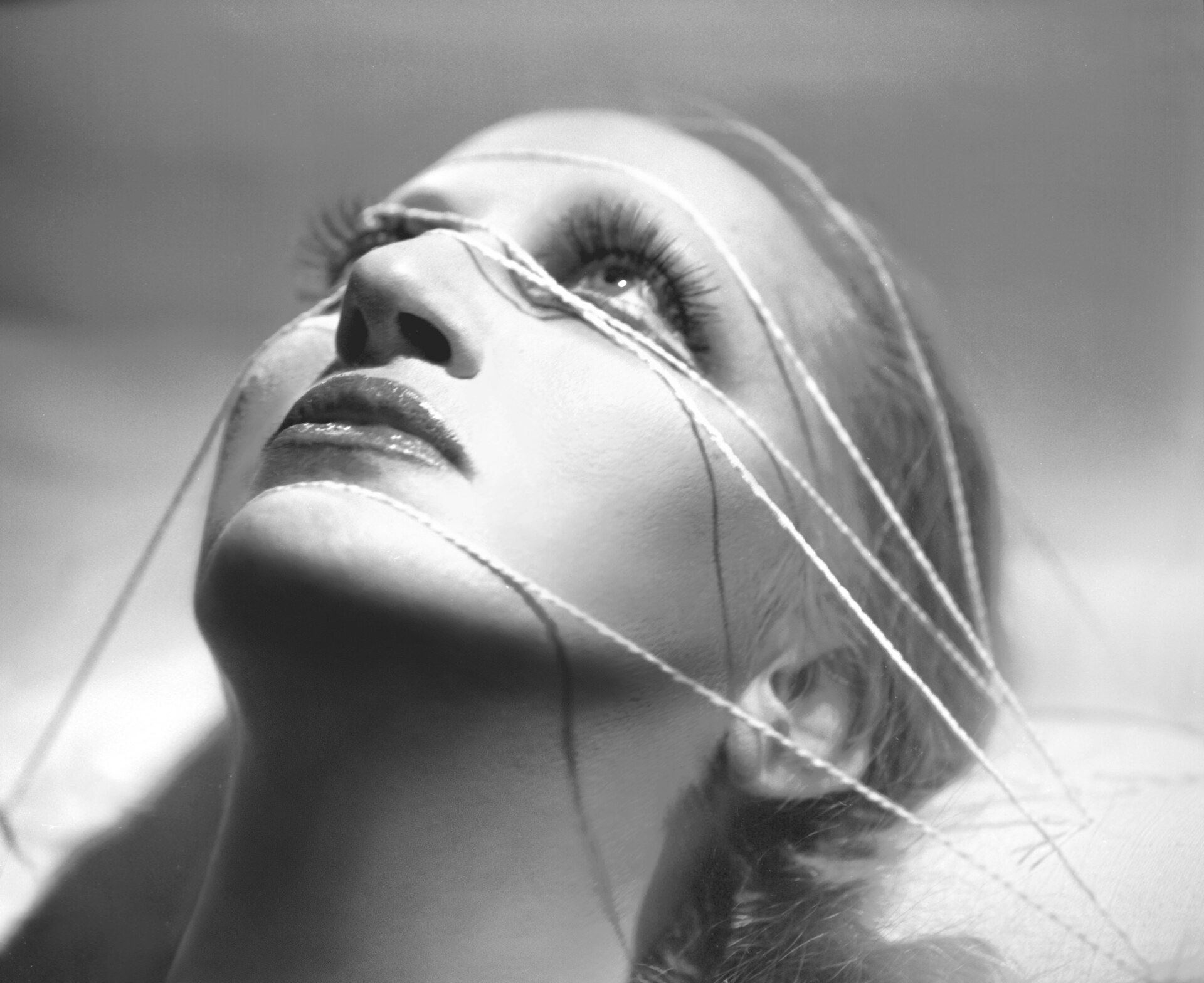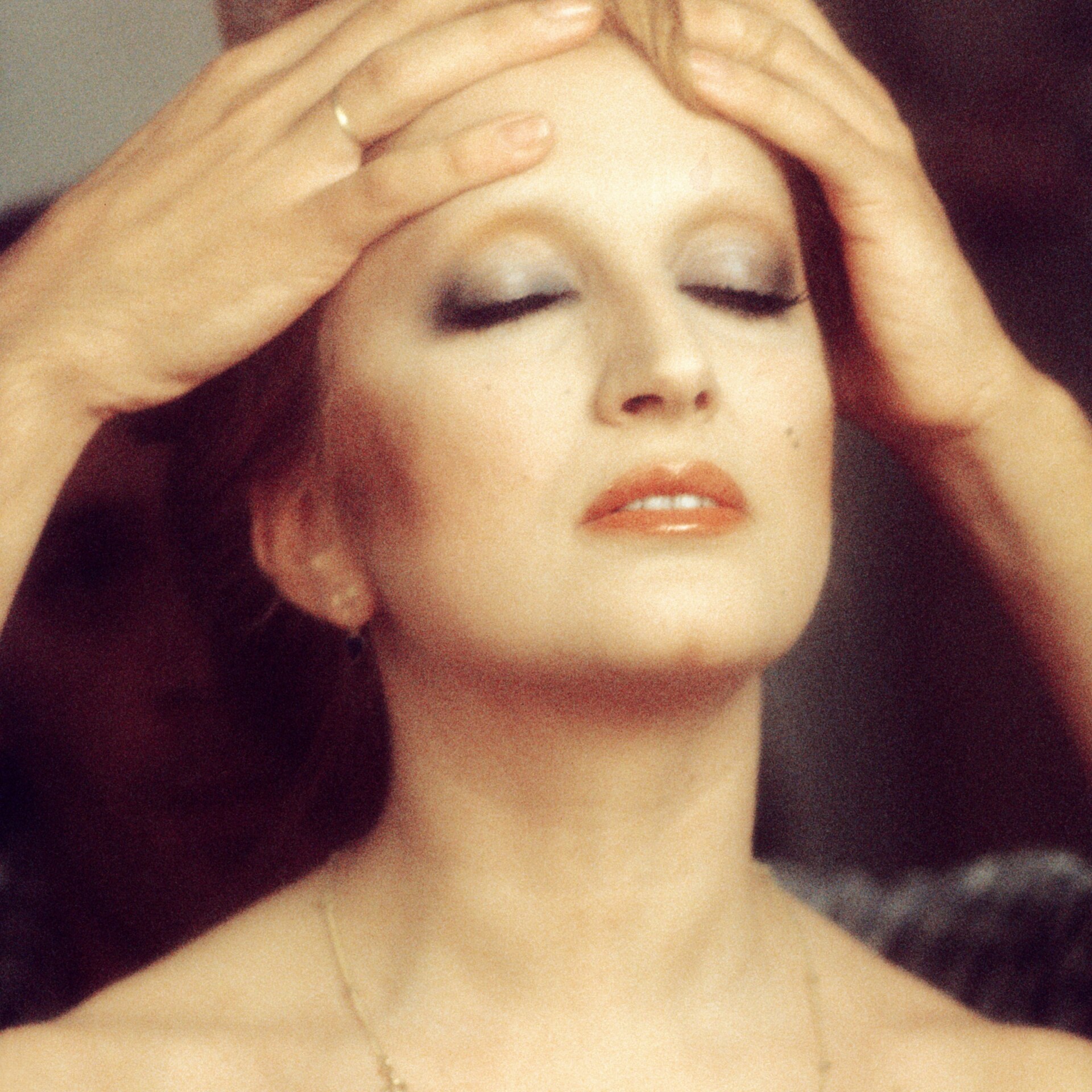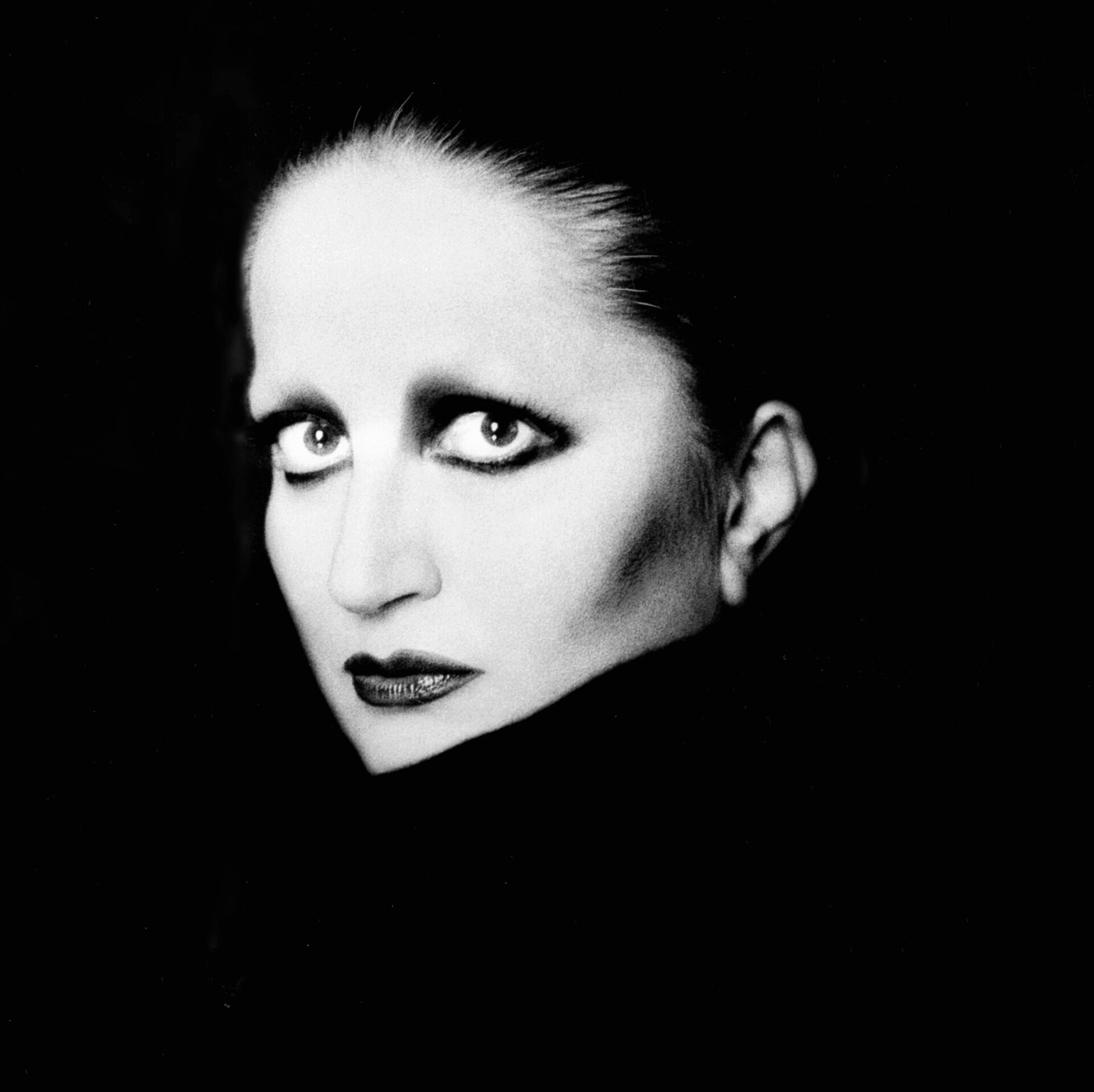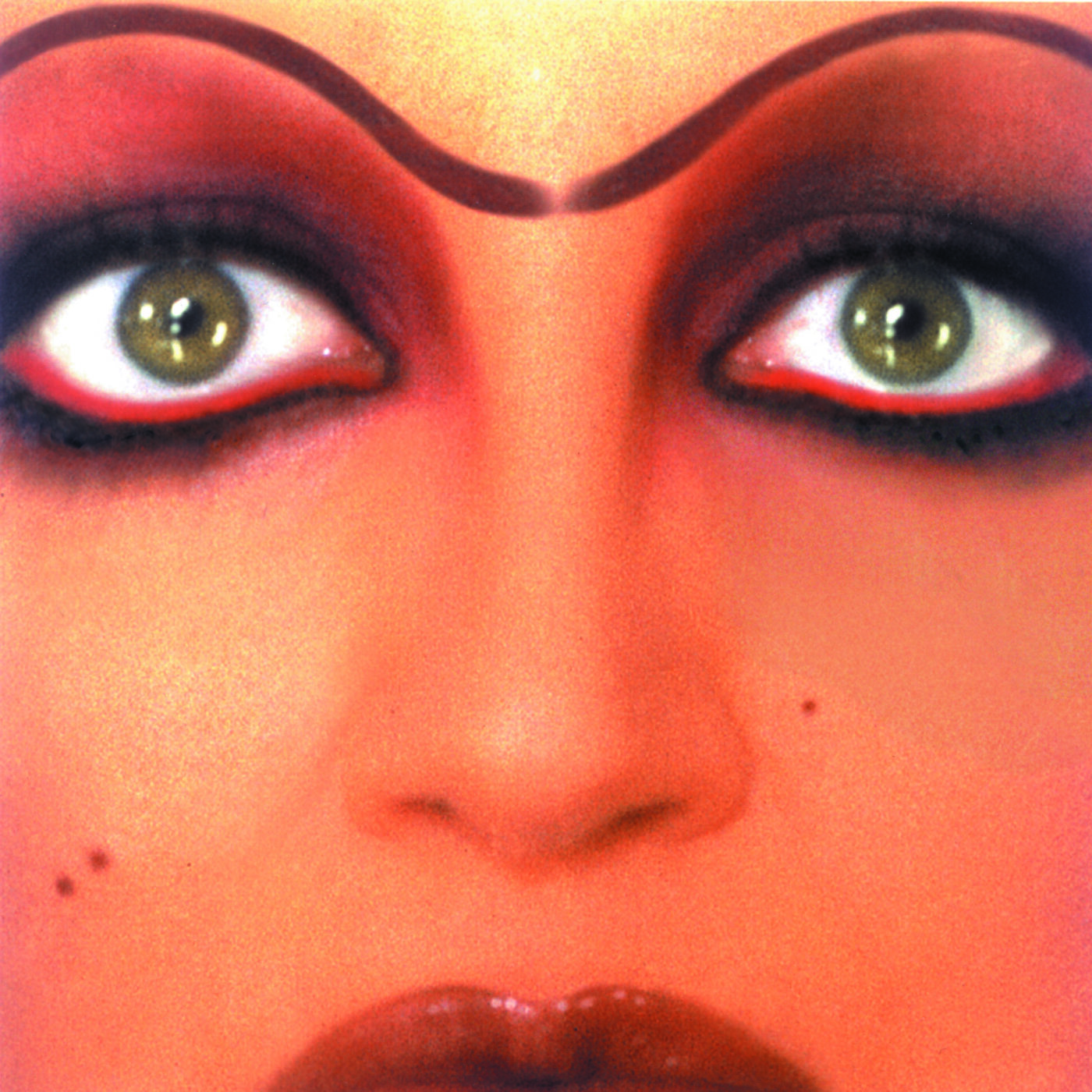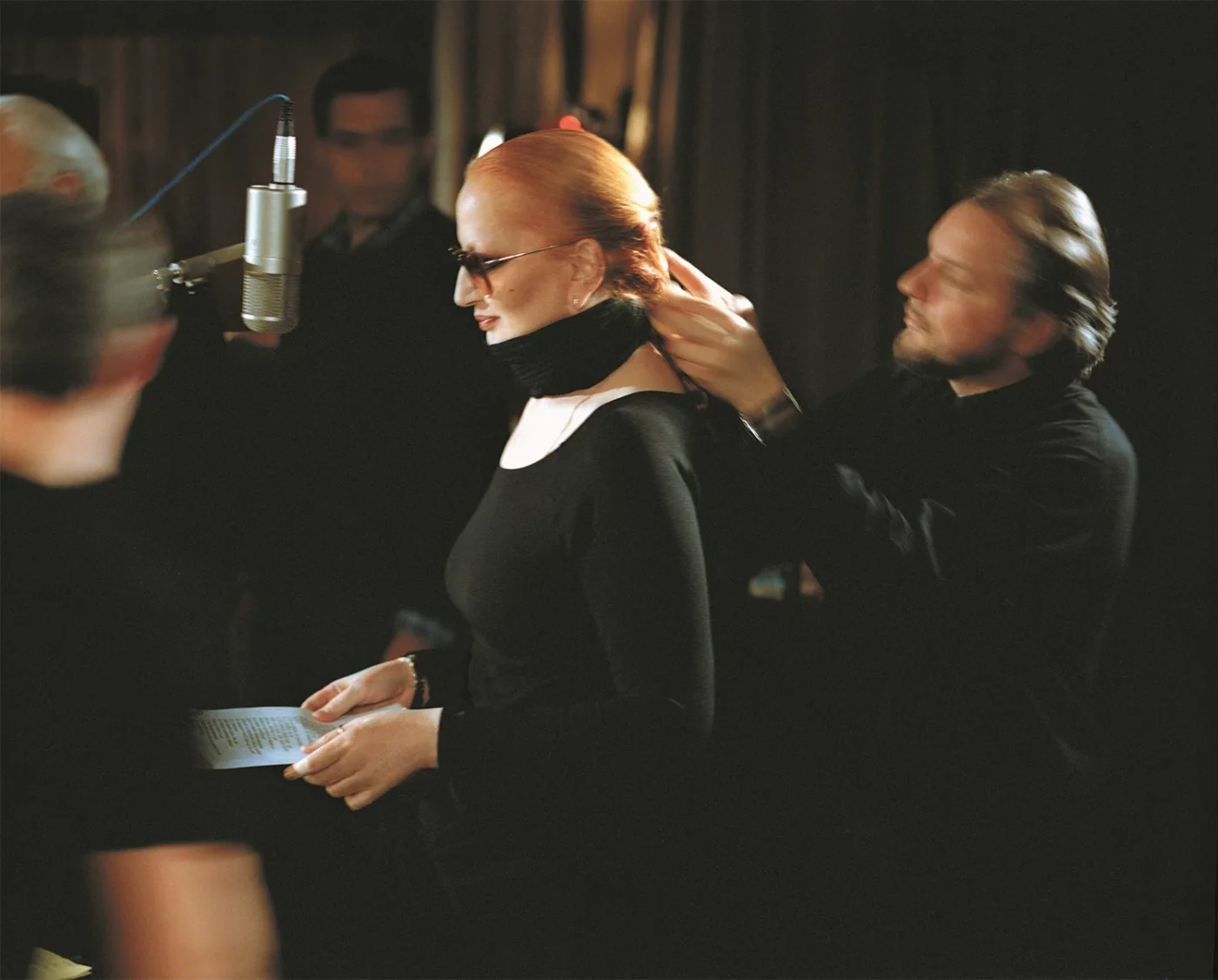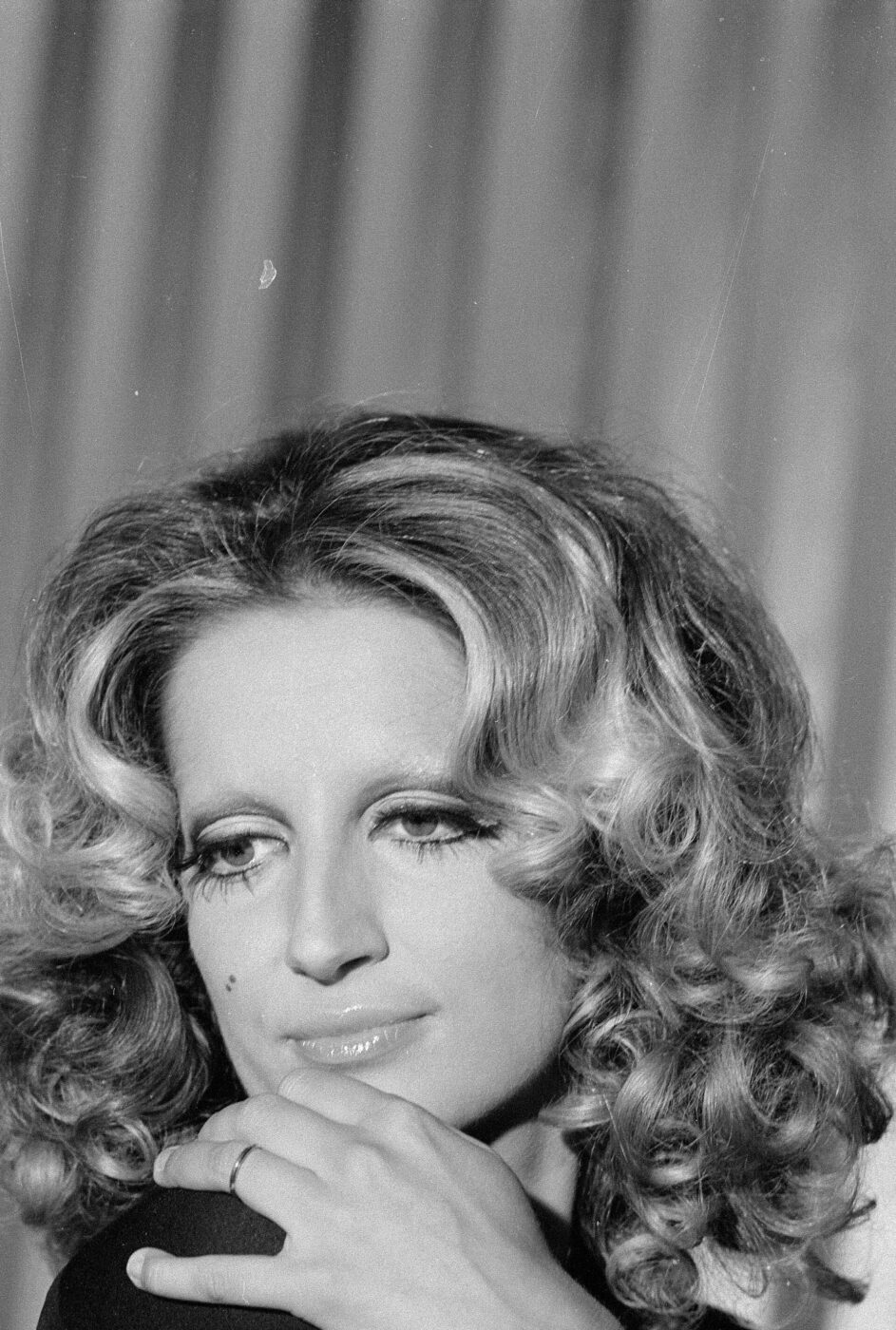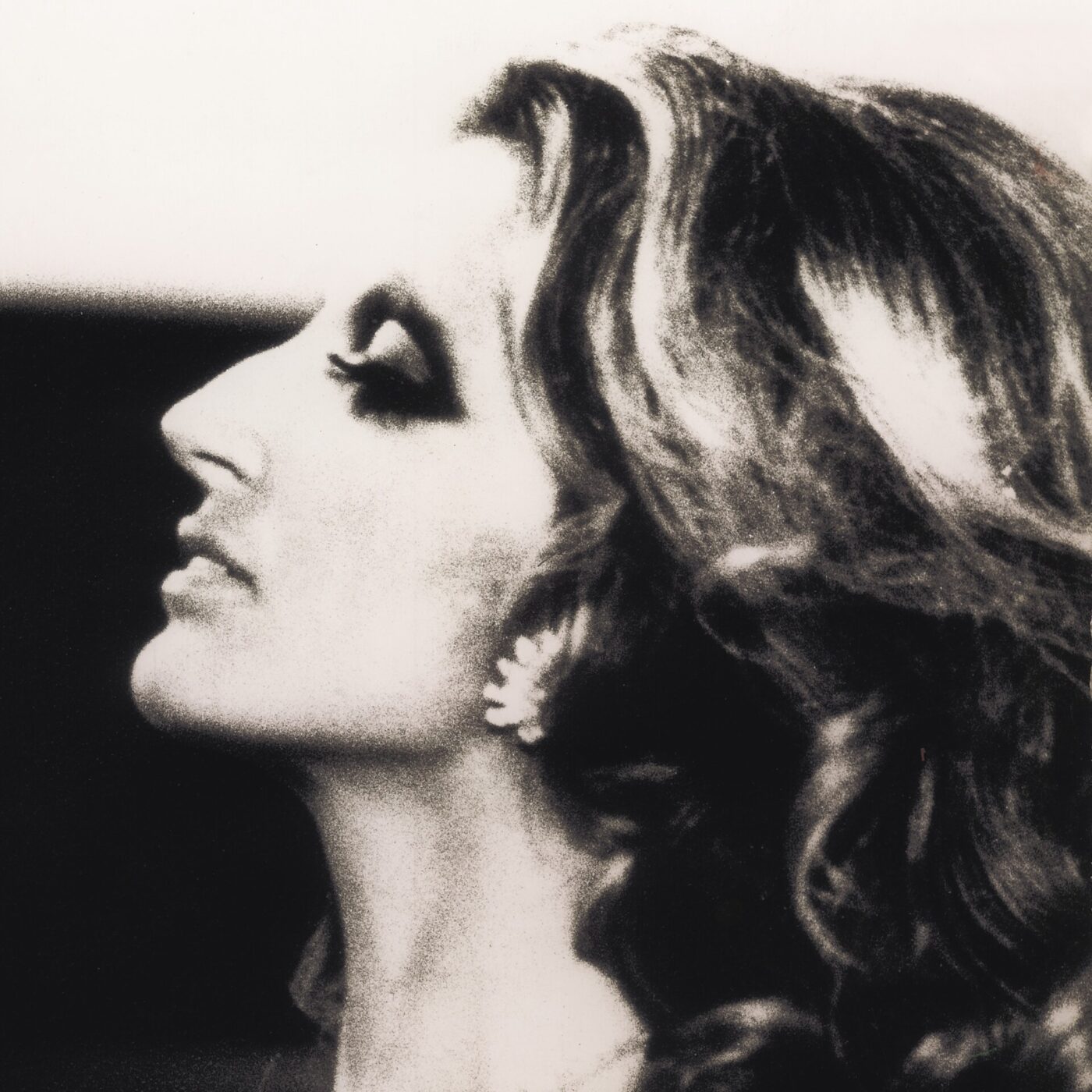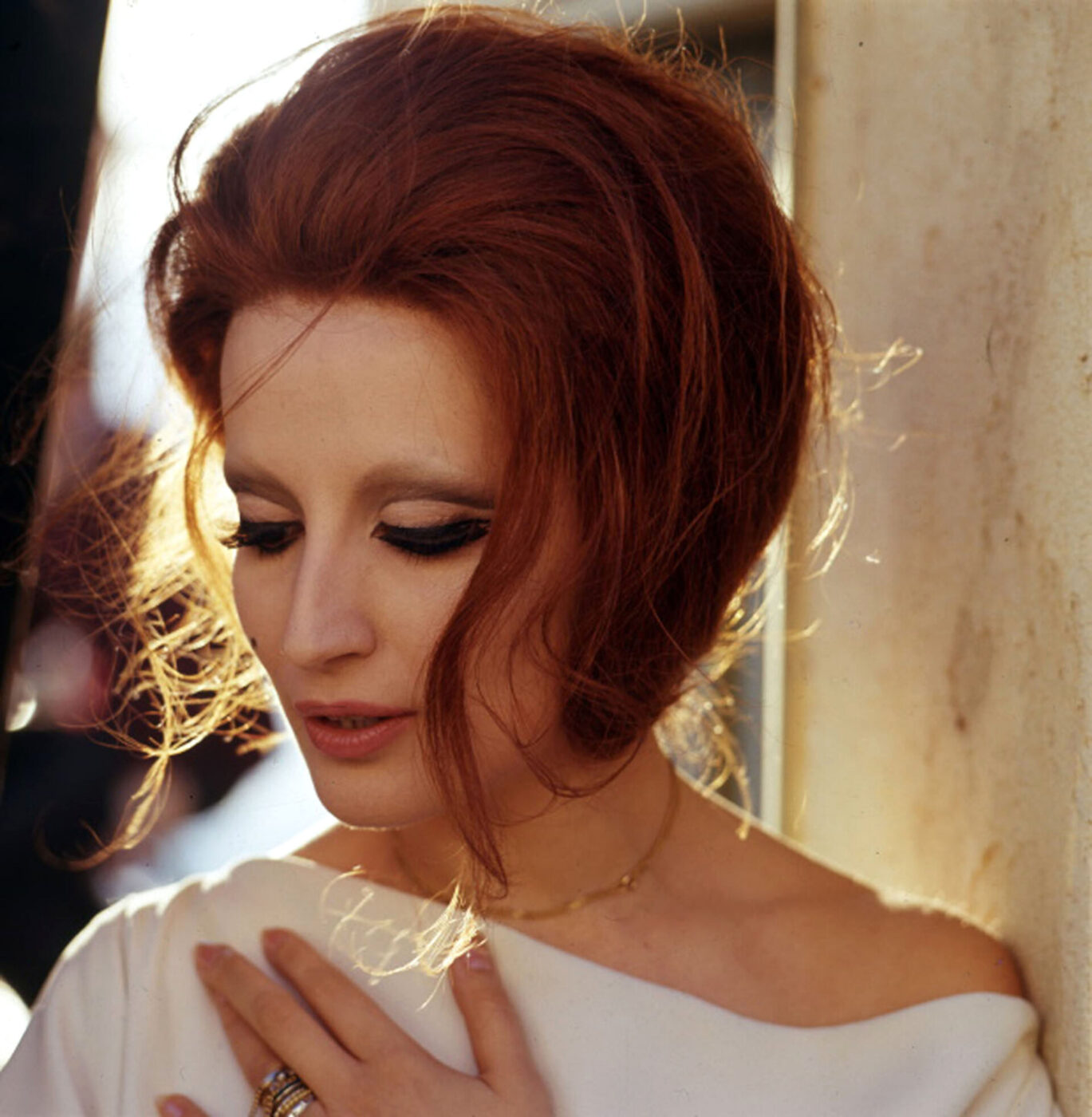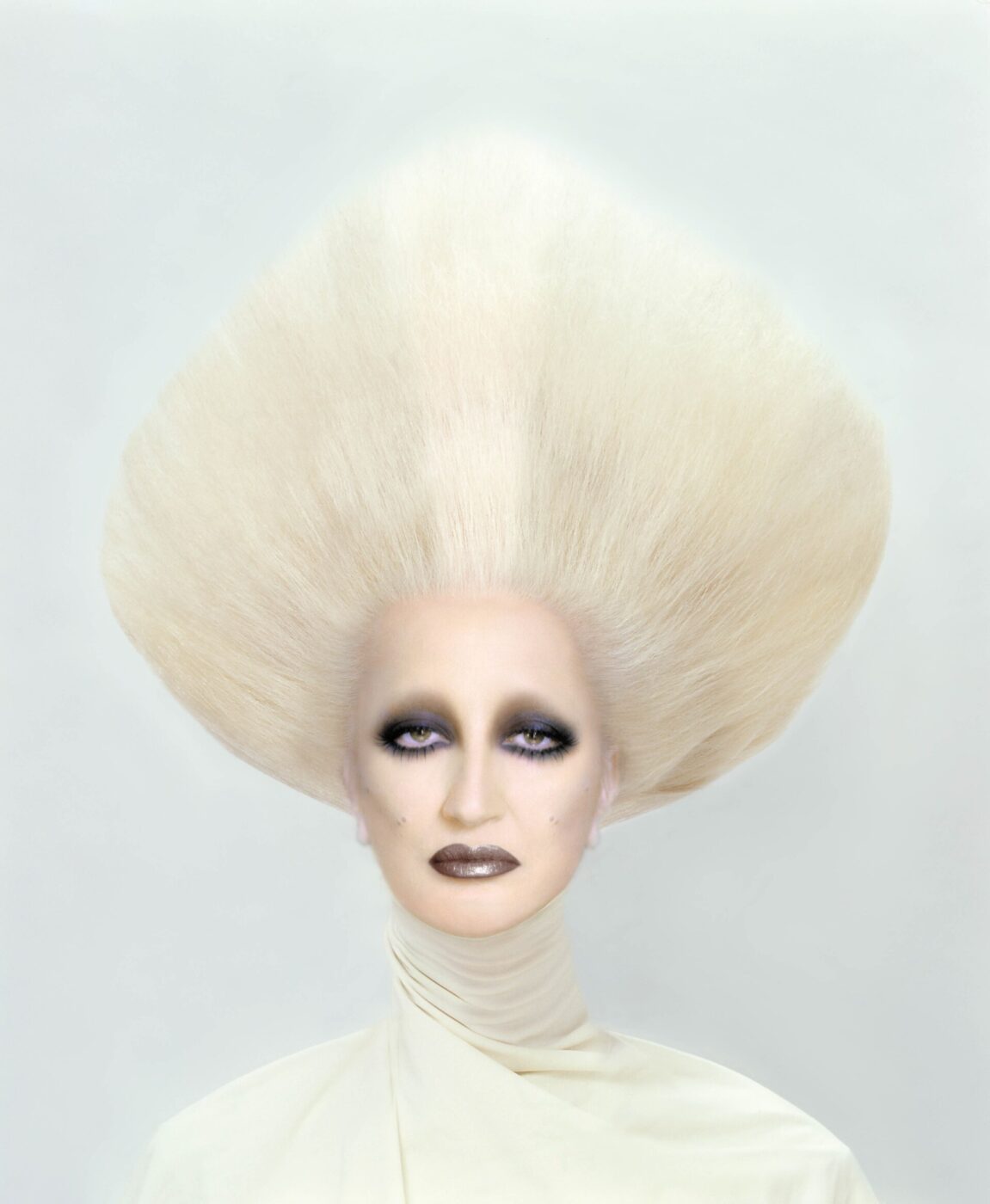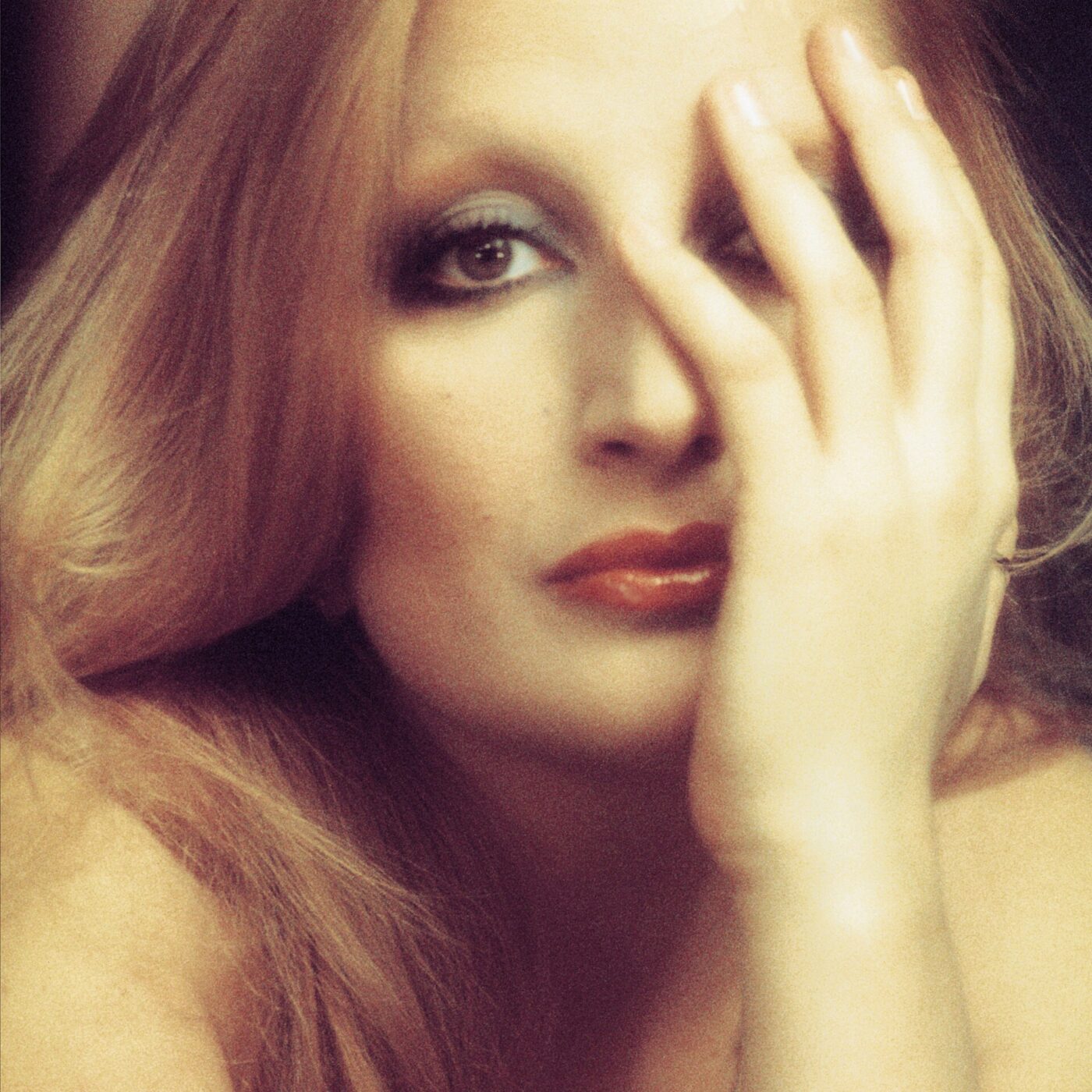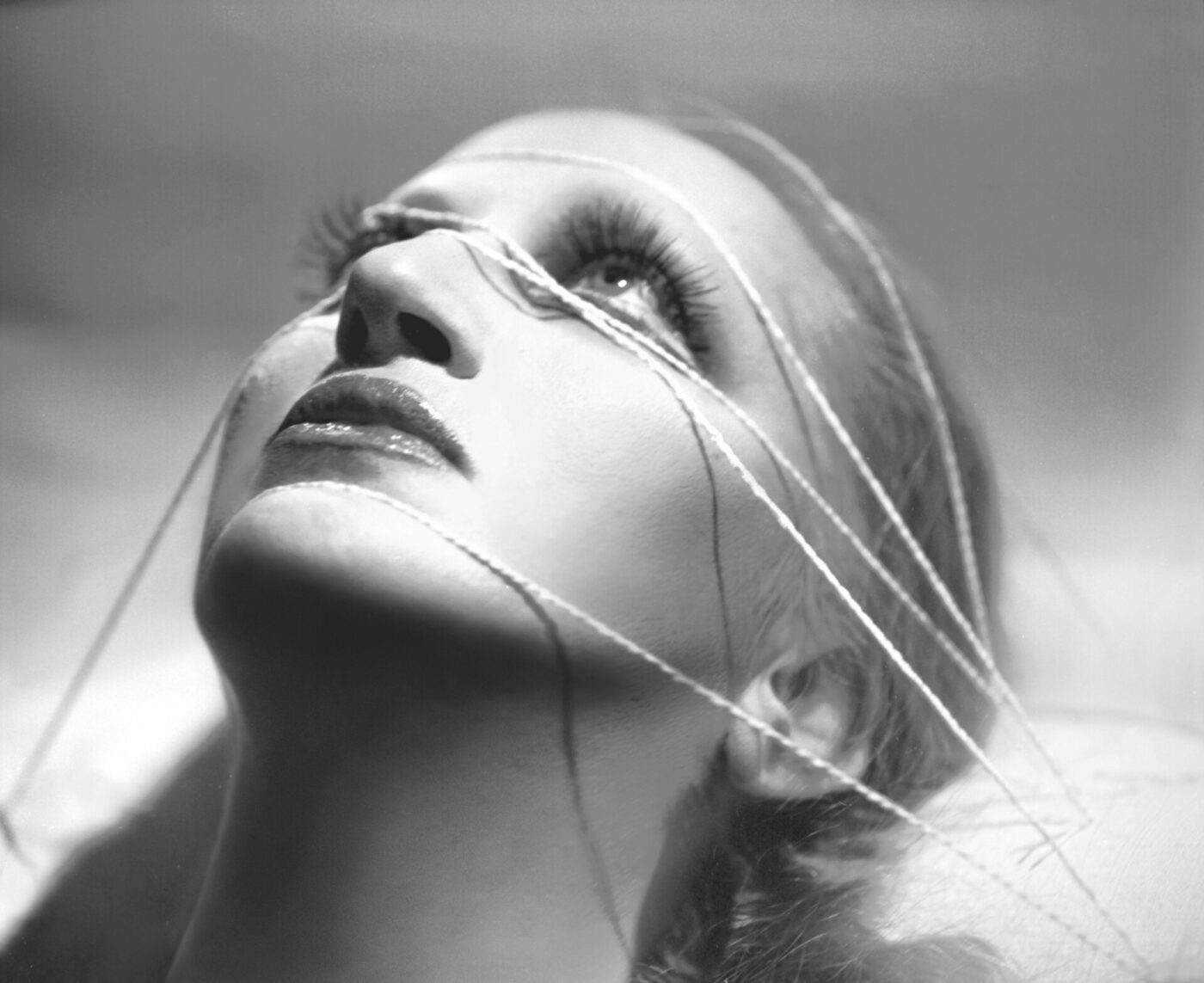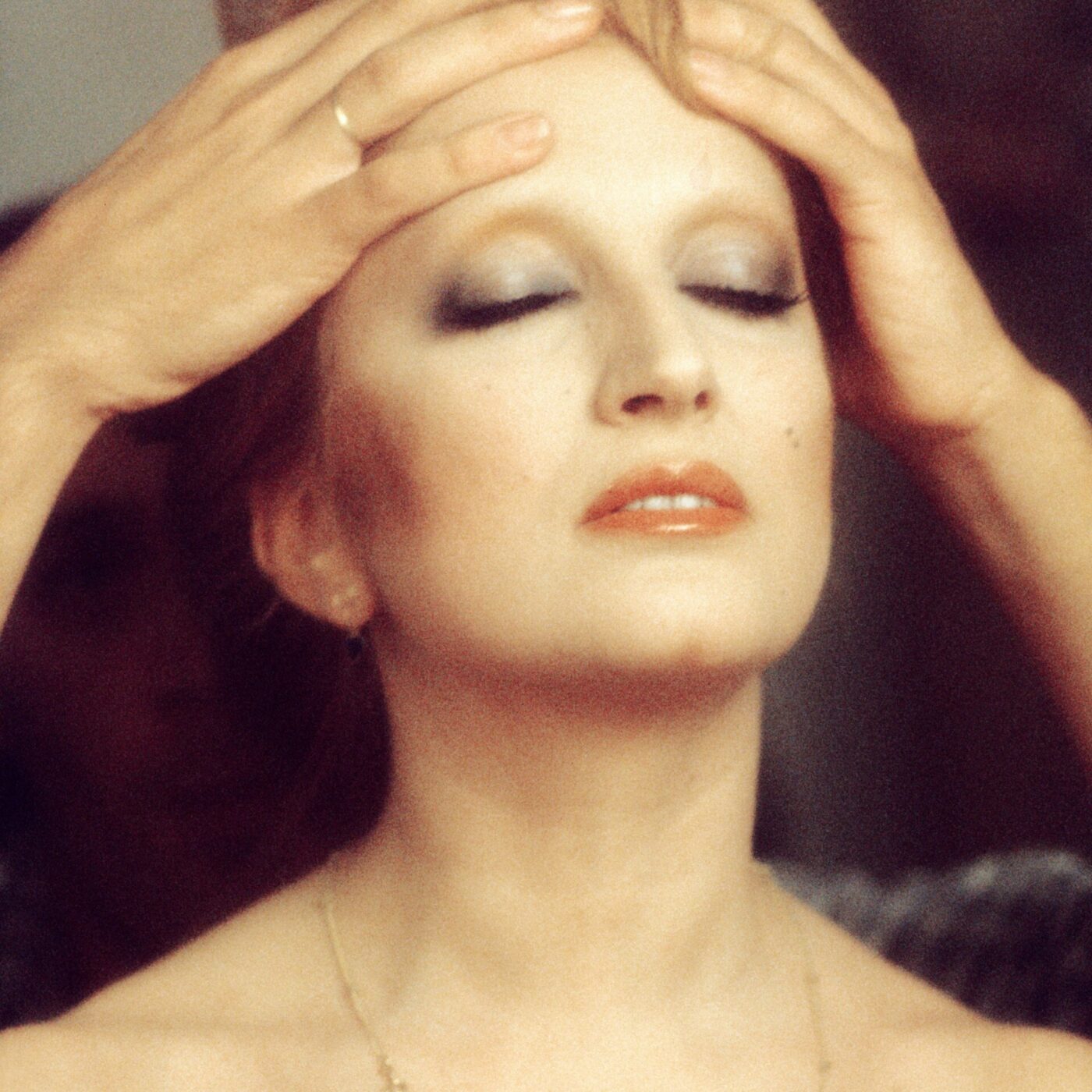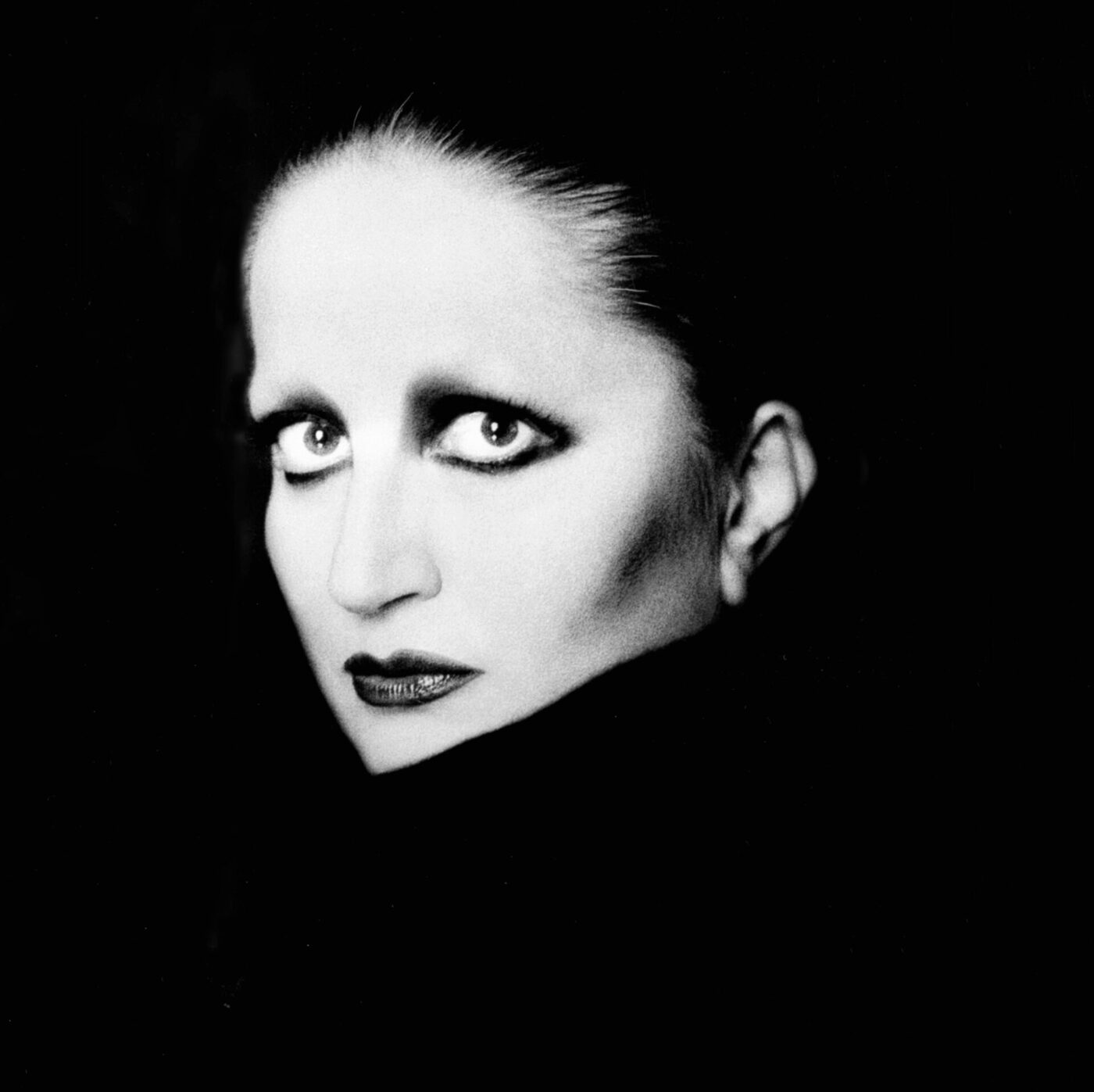I’m waiting for the moment to call Stefano Anselmo, the renowned makeup artist of Mina Mazzini, often referred to as “the maestro” by his colleagues and the students of his eponymous makeup academy, where he serves as founder and creative director. As I wait, I scroll through the covers of Mina’s albums on my screen.
In the background, the voice of her official photographer, Mauro Balletti, narrates: “We’ve always played and still play together—the great illustrator Gianni Ronco, myself [Mauro Balletti], and the legendary makeup artist Stefano Anselmo—under Mina’s direction, which unleashes the creativity of everyone collaborating with her in any direction. Her face transforms just as she has always experimented with her voice: testing tones that are always new and diverse, exploring every musical genre. Similarly, experimenting with her face is a marvelous game that has been going on for nearly fifty years.”
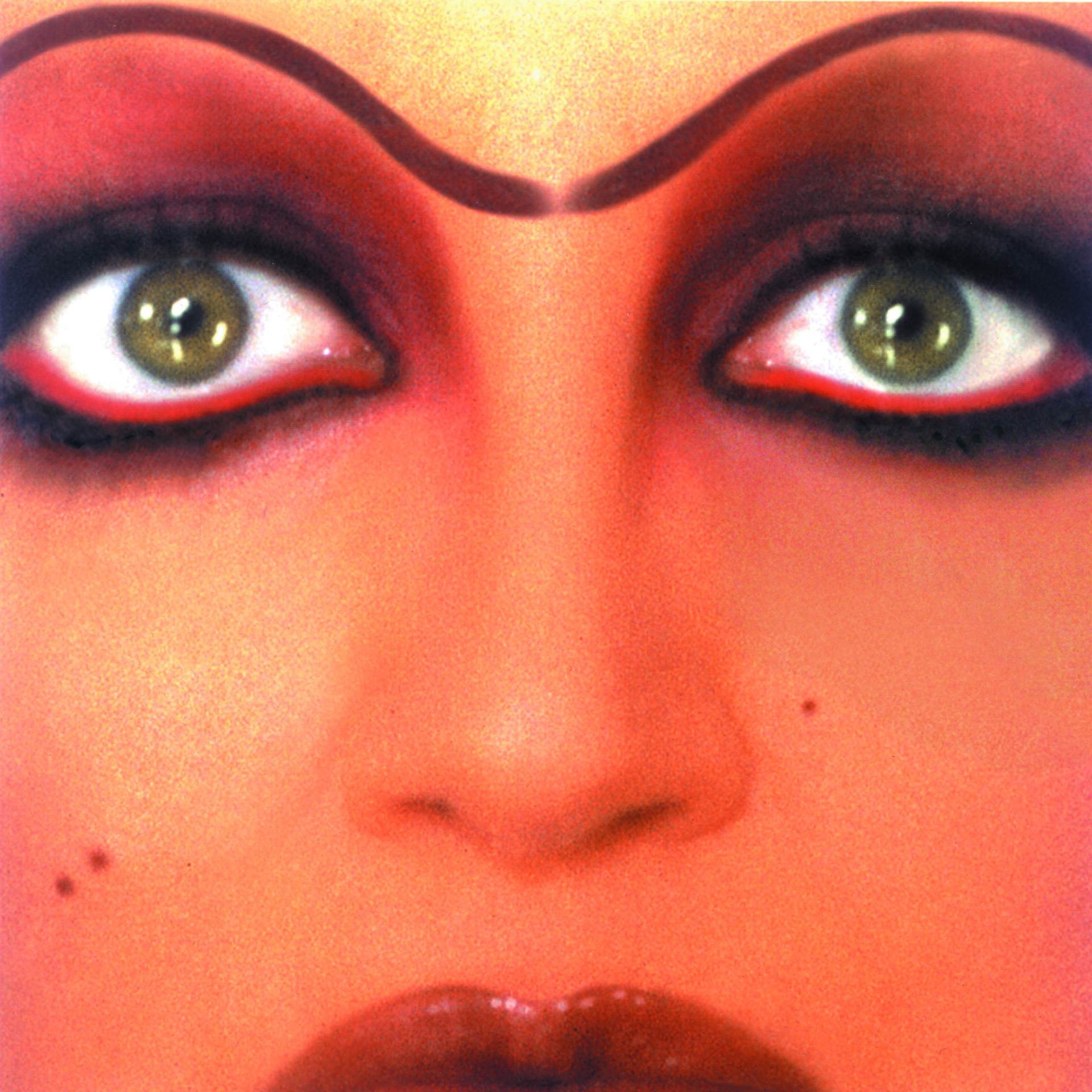
Mina in 2001; photo by Mauro Balletti ©PDU
Mina’s face is like a blank canvas, where makeup, rather than being used to beautify, becomes a narrative and dramatic medium. The ever-evolving makeup looks created on and for her—eclectic, avant-garde, theatrical, and painterly—span genres and styles, drawing inspiration from silent cinema to Ancient Egypt, from Leonardo to Picasso. It’s a matryoshka doll of ideas distilled into shading, dramatic chiaroscuro—like the iconic Mona Lisa-inspired makeup for the Olio cover—and bold graphic elements, such as the Cubist-influenced design of Del mio meglio n.7. Yet, no matter how varied, they all share a common thread: the ability to enhance the natural intensity of her eyes and gaze, already striking on their own. And within this endless gallery of Mina’s ever-changing yet instantly recognizable faces, we see the vision and artistry of Stefano Anselmo.
By the time the phone starts ringing, my mind is already buzzing with curiosity and questions for Anselmo—about his work, his decades-long collaboration with Mina, and, above all, the creation of her iconic makeup looks, from eyebrow erasure to half-moon eye shadows. Designed for both her performances and album covers, these looks have not only shaped some of the most unforgettable images in music history, but continue to inspire designers, performers, and artists to this day. “One of Mina’s distinguishing traits is her projection towards the future—being always herself without ever repeating herself, an icon who sets trends and transcends them,” Anselmo tells me.
What follows is a dialogue that touches on inspirations, anecdotes, and, above all, a 50-year-long story of mutual understanding, great trust, and reciprocal respect between the two artists.
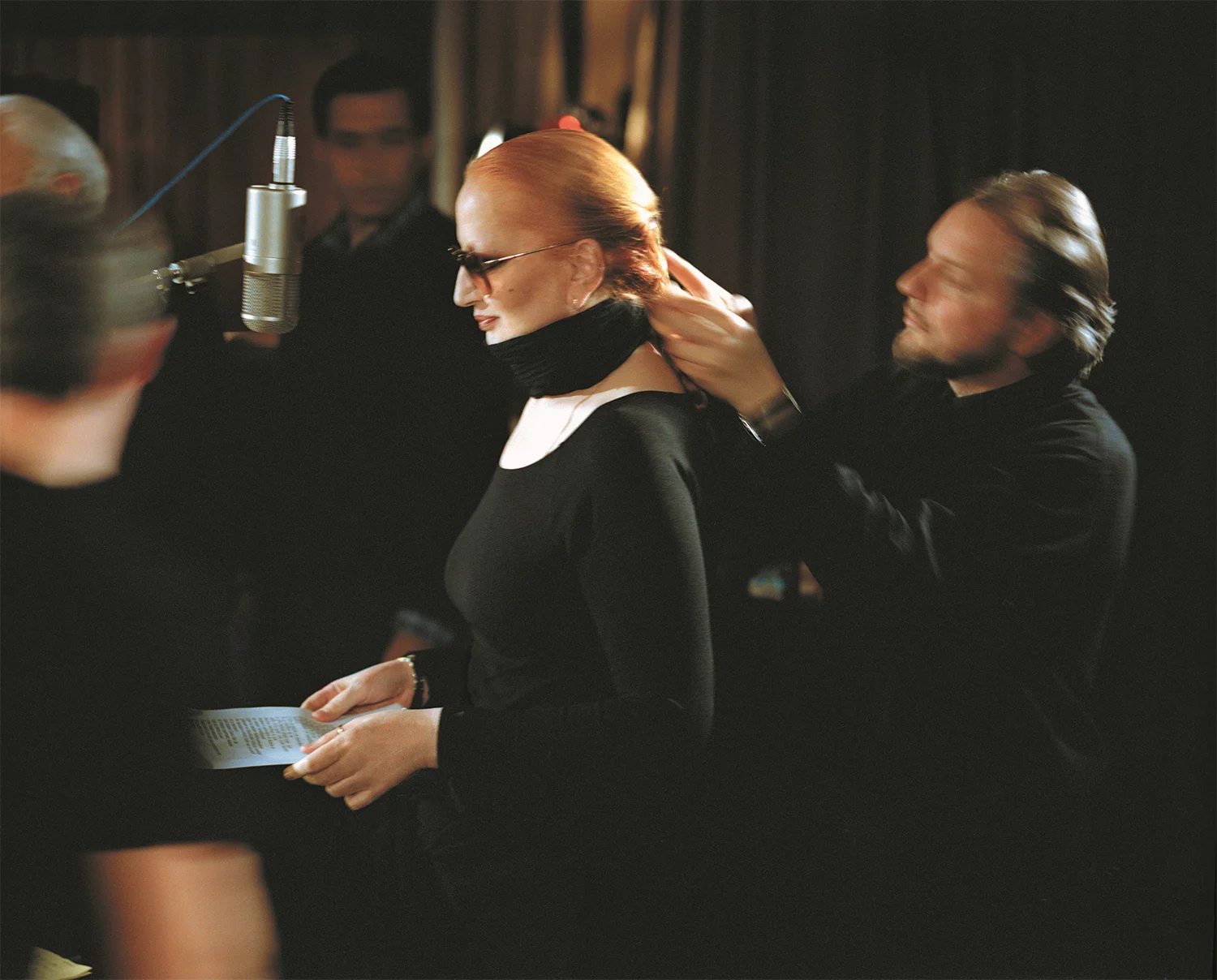
Mina in studio with Stefano Anselmo
You first met Mina through Mauro Balletti, who was already her sole authorized photographer at the time. Could you tell me about it?
Around the late 1970s, Balletti was looking for a new makeup artist for a shoot. At the time, I was working at Geneviève in Milan. His sister, Lia, knew me and spoke to him about me. Shortly after, he called me for a test photoshoot. I had no idea it was a trial or that Balletti was Mina’s photographer. During that session, I did the makeup for another singer, Delia Gualtiero, and he liked the result. Then came Mia Martini. Finally, having observed my distinctly painterly style, he gave me the green light to work on Mina’s face. They called me at work, saying there was an opportunity to do Mina Mazzini’s makeup. The occasion was a photoshoot for images destined for the press, marking her return to the music scene after five years.
And how did you feel about it?
I accepted, feigning complete indifference, but of course, I was already a huge fan of Mina, even before meeting her! In truth, in my foolishness, I wasn’t even that nervous—in fact, I was quite self-assured. Perhaps it’s because, in my mind, I had already done her makeup a thousand times. The first time we met was at her home in Milan, in the Montenapoleone area. When I saw her enter, wearing this long black nightgown, her pale face, like a girl’s, without makeup, I was immediately struck by her luminosity and energy.
On that occasion, I did a makeup look that, rather than following the continuity of my predecessors’ work, aligned more closely with the image of her I had in my mind. Once finished, I remember her saying, “You came along and changed everything—you’ve done something completely different!” The truth is, I had already imagined that look countless times in my sketches: her face has a shape that has always inspired me. It was always Mina, and she was always made-up like that.
Did anyone or anything inspire you when creating makeup for her face?
In 1965, Mina did a series of Barilla commercials directed by Piero Gherardi, the renowned costume designer for Fellini. A highly imaginative, extremely cultured person, he took inspiration from art history for the occasion. Mina was filmed in surreal, metallic, unreal environments, wrapped in a long white drape—very much a Fellini-esque atmosphere. Goffredo Rocchetti, “the hand,” created a shadow along the bridge of her nose that elongated it even further; it almost seemed like a mistake. In reality, it added another dimension to her face, creating a stark contrast between the forehead and the nose, intensifying her gaze.
Then he designed the famous crescent moon shape between the fixed and movable eyelids, essentially replacing the natural eyebrow arch. It was identical to the one visible on the bust of Nefertiti in Berlin and became her signature look. I’ve always drawn on that shadow because it was ingenious on her.
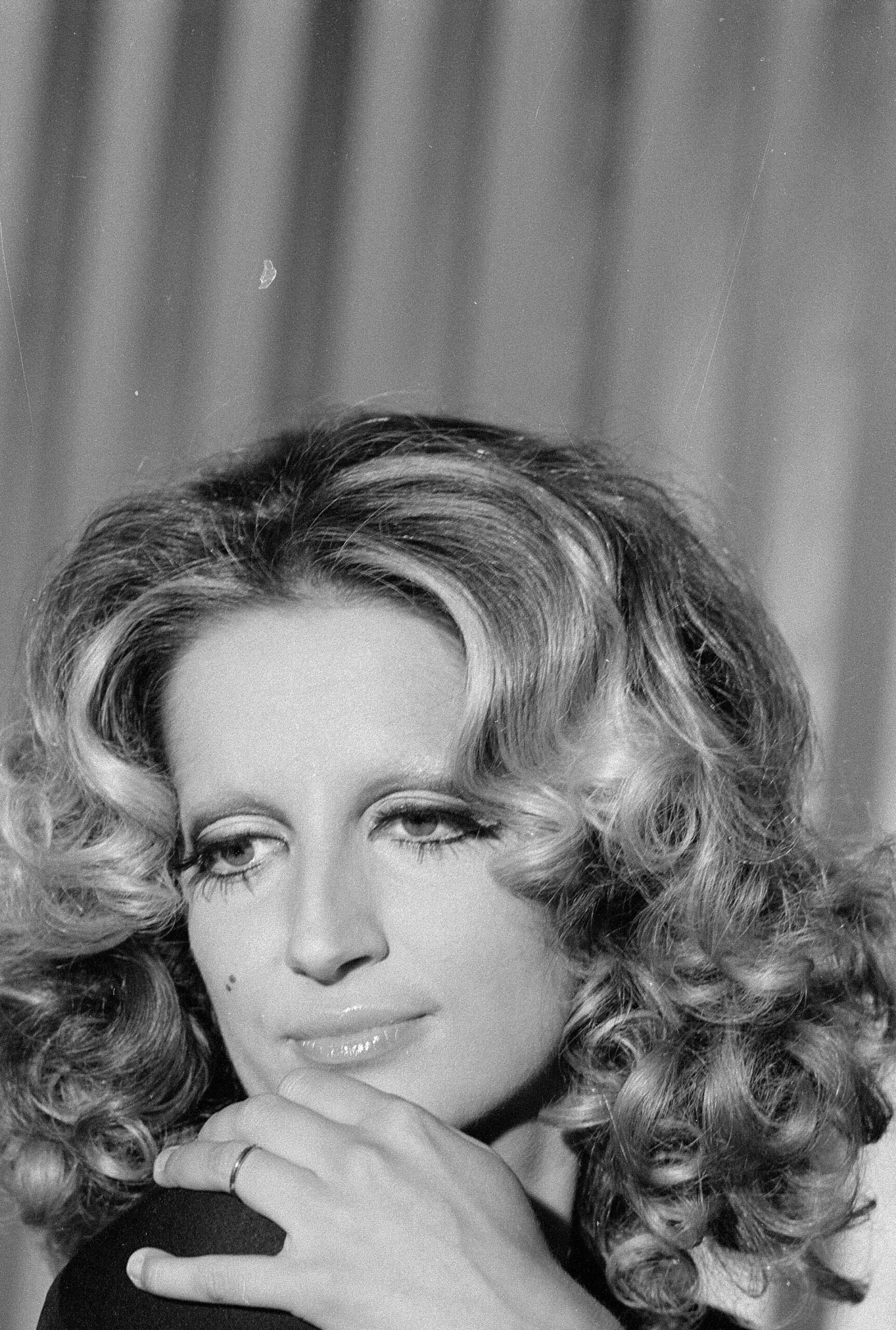
Mina for the Barilla commercials; photo by Roberto Bertolini ©PDU
How would you define your style? What are its cornerstones?
I’m passionate about Ancient Egypt and African art and anthropology. I find the deconstruction of facial planes and the reconfiguration of classical proportions to create a different balance fascinating.
When I do makeup “for beauty,” so to speak—without creative or narrative intentions—I never use colors; I only use neutrals, either warm or cool, exaggerated to varying degrees, in shades of brown and black. I work heavily with chiaroscuro, aiming to create three-dimensional rather than decorative makeup. My approach is distinctly painterly, almost “sculptural”: inspired by Renaissance masters. I work a lot with planes and volumes, accentuating or shaping them, creating optical illusions.
It’s essential to distinguish between the person and the makeup. If the purpose of the makeup is to enhance someone’s features, the approach will inevitably differ from a fashion or photoshoot. In the latter, you can indulge in cosmetic acrobatics because the makeup is the star of the show.
Was this also the case with Mina?
Yes, but with her, I had a lot of fun in every situation because I could always make her up differently, while often maintaining a consistent palette. It’s also true that Mina has a unique quality that comes from within, even more than from her particular facial features. Think about it: she’s worn hundreds of styles and always-new makeup looks, yet she’s never stopped being herself. You look at her, and it’s always Mina. Some people can change the color of their lipstick, and you no longer know who they are. Not Mina: what’s behind it is so powerful that it transcends any mask.
Moreover, her face was already, in itself, a “mask” in the ancient sense, with pronounced traits and highly expressive features. Just think of her eyes or her classically lined nose, which sometimes gives her a slightly haughty air.
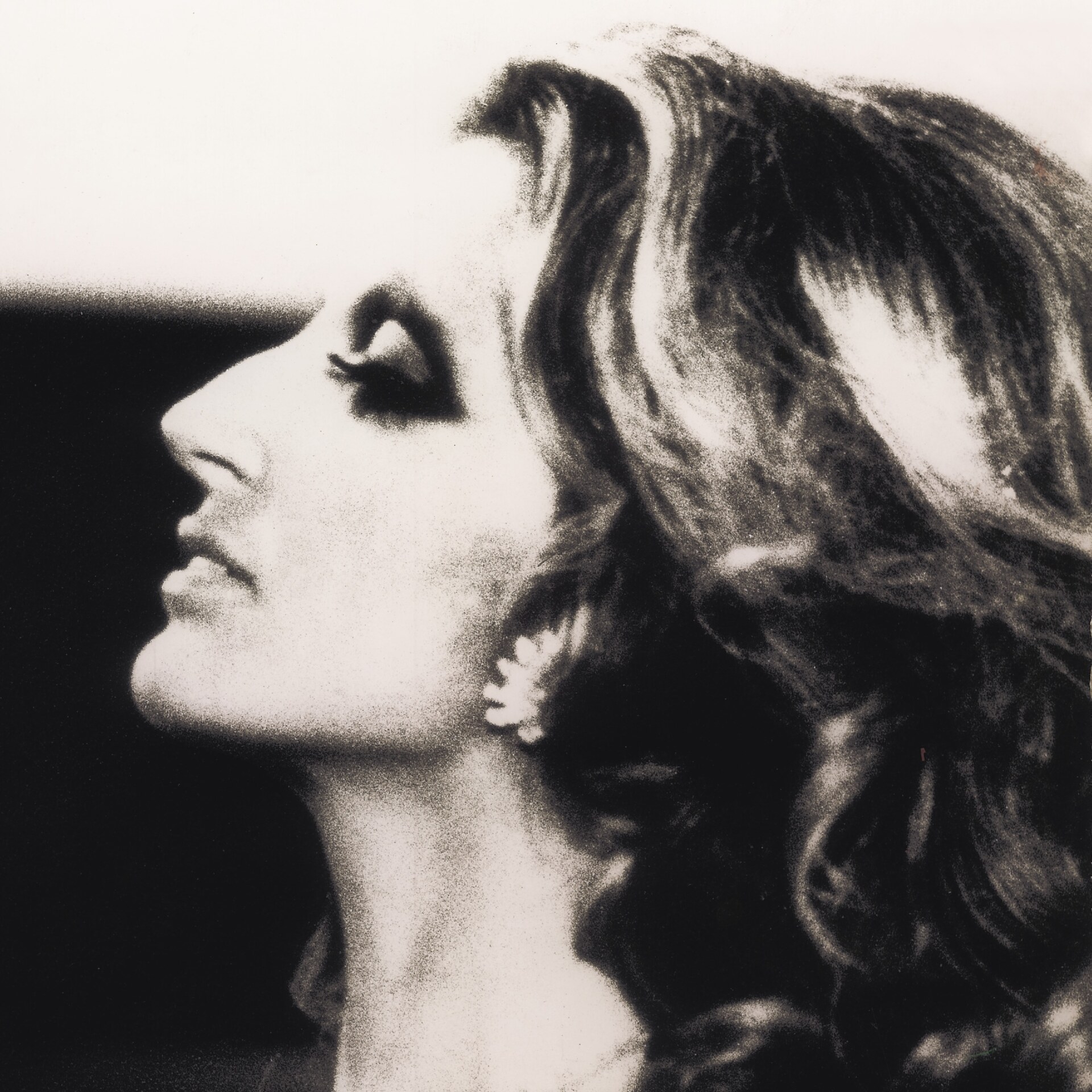
Mina's pronounced traits coming through in a Barilla commercial; photo by Roberto Bertolini ©PDU
What has been the most rewarding aspect of collaborating with her?
Firstly, she’s fearless. Secondly, she’s creative, loves to surprise, and embraces any new idea you propose, while still expressing her preferences. One of Mina’s distinguishing traits is her projection towards the future—being always herself without ever repeating herself, an icon who sets trends and transcends them.
Being very intelligent, she selects images based on their impact, not on how she looks or her beauty. And she’s very trusting. I remember, for example, when I did her makeup for the title sequence of Mille e una Luce, where she sang “Ancora, ancora, ancora”. I did her makeup, the hairdresser styled her, she put something over her shoulders, and, without even looking in the mirror, she said, “Shall we go?” I asked if she didn’t want to check, and she replied, “Does it look good to you? If it’s fine for you, it’s fine for me.”
Before delving into some of the most iconic album covers, I can’t help but ask about what has essentially become Mina’s iconic and much-imitated look: the one without eyebrows.
There have been some esteemed colleagues who claimed to have invented this look, but in reality—and I make a point of specifying this every time because no one ever mentions it—it was a RAI makeup artist named Enrico Farina. He was a very reserved person, to the point that there’s almost no documentation about him. The only existing record is a document from the RAI dressing rooms in Naples: two photos, a before and after, with a dedication that reads “your Mina, with and without eyebrows.”
The issue was that Mina’s natural eyebrows weren’t particularly well-shaped. Over the years, she had also overplucked them. Farina gave her a makeup style that was a new trend in the late 1960s, with heavily accentuated eyes and a nude mouth. He initially applied a particularly bold makeup look, without lipstick. At that point, Mina asked him what to do about the eyebrows, and he replied, “What if we get rid of them?” The result was groundbreaking, and the impact was monumental. David Bowie, Grace Jones, Patti Pravo, and countless fashion campaigns—I’m thinking of Fendi—and many films, like C’era una volta by Francesco Rosi or the character of Jocasta, played by Silvana Mangano in Pasolini’s Edipo Re.
Afterward, the complete removal of eyebrows was replaced with bleaching. I think of Donna Jordan in photos by Toscani, Lara Stone for Calvin Klein Makeup… the list is endless, and the look remains highly contemporary.
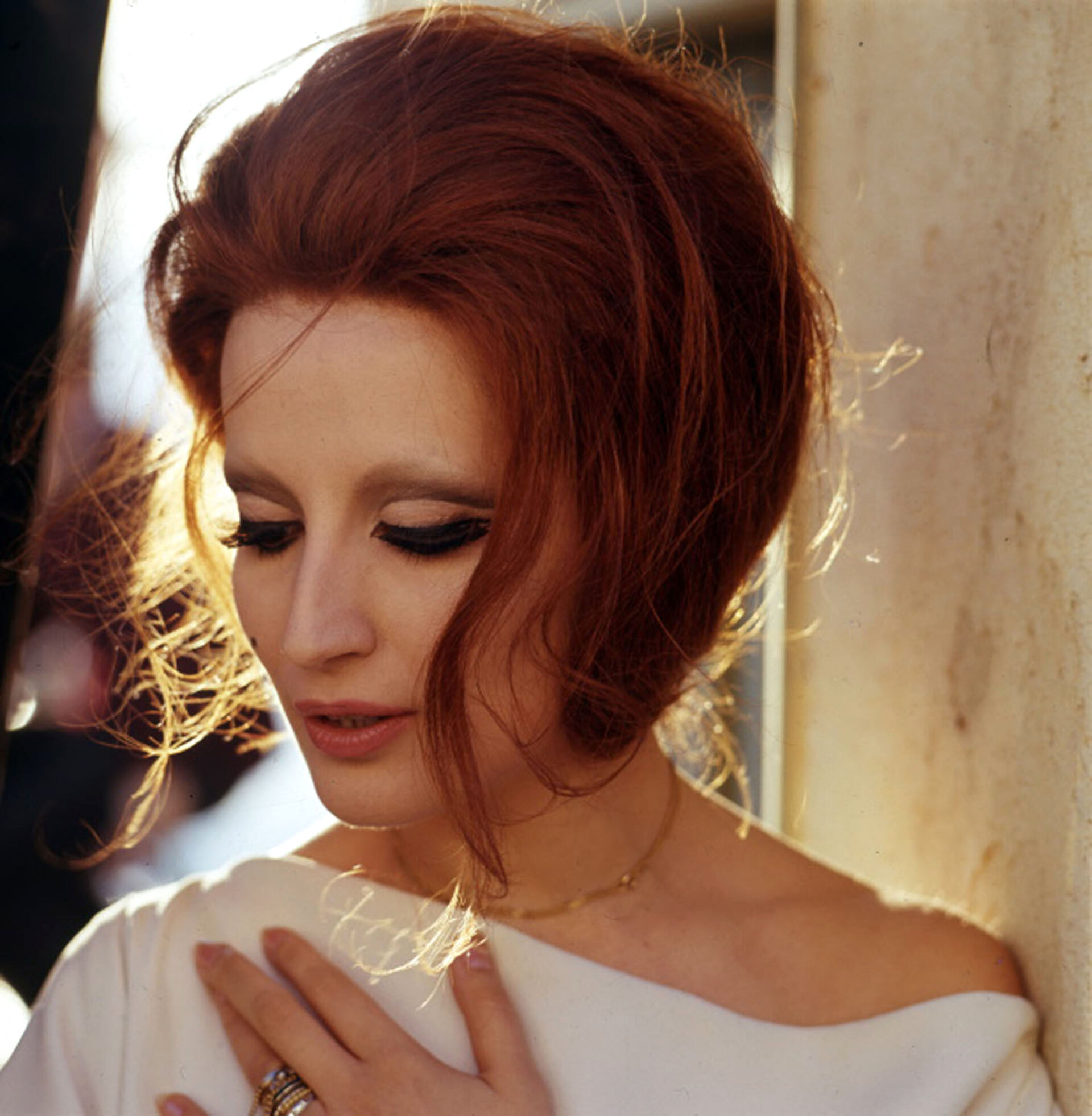
Mina's performance of Ebb Tide for Barilla; photo by Piero Gherardi ©PIERO PASCUTTINI / GRAZIANERI
But if we go much further back in time, there’s the Mona Lisa—she, too, had no eyebrows. And perhaps not coincidentally, Mina became the Mona Lisa on the album cover for Olio.
Yes. For that cover, I created shading that mirrored the original painting. It was more natural makeup than usual, and Mina felt strange seeing herself like that—she was already used to having dramatic eyes. Here, I used brown and green pastes for the shadows, ochre for the highlights, and powder to unify it all. The saturation and craquelure effect were added digitally. This is one of the covers I enjoyed working on the most. Mina held a book with the painting’s image, and while she held it, I reproduced the chiaroscuro on her face.
How did ideas for covers come about?
Very often, the album titles were unrelated to the images we created. We always agreed on general ideas and then developed them on the spot, often spontaneously. We had built a very tight-knit team with Mauro and Gianni Ronco; we all created things we mutually enjoyed, so everything came naturally. We were on the same wavelength, and there was no discord. When we met, we’d talk for 15 minutes, at most half an hour. We all always had plenty of ideas up our sleeves, which we’d bring to the table, discuss briefly, and then, with that shared framework, we’d finalize the ideas. Many covers were born this way. Also, Mina is always very quick: if things take too long, she gets bored. The same goes for photos: when the photo is right, she knows it immediately.
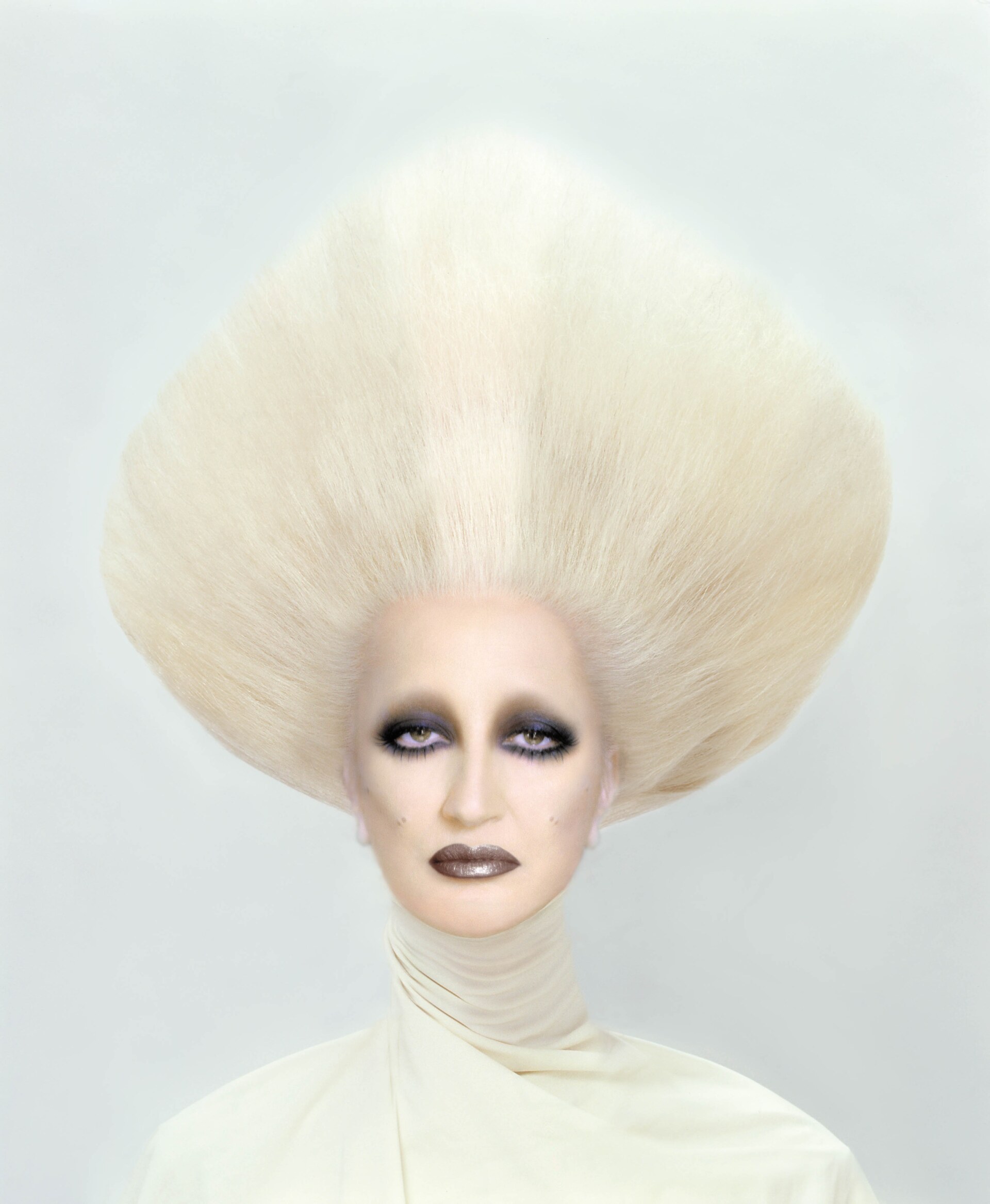
Mina on the cover of album Veleno; photo by Mauro Balletti ©PDU
Can you share any trade secrets and behind-the-scenes from some of your favourite cover shoots?
I could tell you about the cover of Attila, an album from 1979. I was indirectly involved in that one; it all started from a drawing of mine depicting Mina’s severed, bald head placed on a surface with vanishing lines stretching into infinity. From there, with the contribution of illustrator Gianni Ronco and working on a photo by Balletti, the double cover emerged—the one with the colored popsicle on one side and the pinwheel on the other.
There was also the stir caused by the Salomé cover, the one with the flowing auburn beard. People said it was a photomontage, but in reality, it was much simpler than that. It was a fake beard, custom-made based on a hair color sample from Mina by a specialized workshop in Turin, crafted on an invisible tulle base that vanished once applied to her face. Aside from the beard, the makeup was light, with just a few golden shadows and brick-colored lips to match the background.
For Catene, the cover featuring the two black-and-white faces, the effect was highly chiaroscuro and elegant. The reference was to dramatic cinema just after the silent film era. The photos were taken in Mina’s kitchen, using light from the window. The background? That was me holding up my open black coat!
On the cover of Cremona, Mina wore a very long cape created for her by Gianni Versace—what he called the realization of one of her dreams—with the collar raised straight up. To keep that collar up? That was also me! Balletti later made my hand disappear in Photoshop. The makeup, on the other hand, revisited the classic crescent shape but more accentuated and high at the bridge of the nose, making it even more dramatic.
Then there’s the mask of Italiana, the icy wig and makeup of Veleno, the mask, the sumo braid, and the photomontage with a bodybuilder’s physique in Rane Supreme, the 3D elements of Sorelle Lumière. Or the Picasso-inspired makeup for Del mio meglio n. 7, which is also one of my favorites.
Do you have a song that you particularly love among her many masterpieces?
I really love “Donna donna donna”, where she tells the story of a crossdresser.
And “Magnificat”, in Latin, a piece with extraordinary evocative power, taken from the sacred music album Dalla terra.
Do you still collaborate?
In recent years, I’ve moved to Vercelli, and we see each other when she needs makeup done or digital retouching. We talk more as friends now. With Mina, you can talk about anything: politics, entertainment, cooking… We even exchange recipes! If someone didn’t know she was a musician, they might never find out because the scope of her conversation is so broad. This is just one of the many facets of her extraordinary intelligence.

Mina for the cover of album Plurale; photo by Mauro Balletti ©PDU
